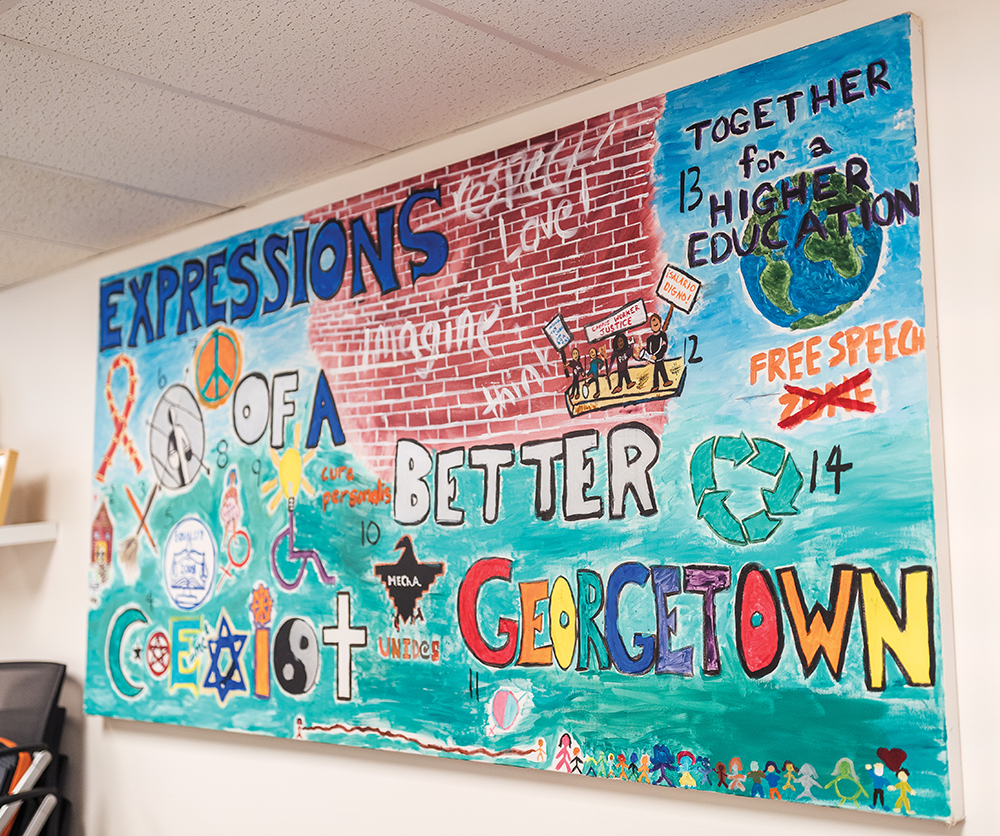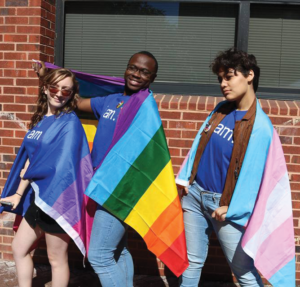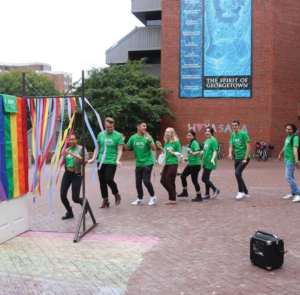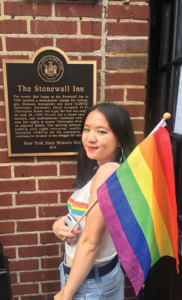
In September 2007, a Georgetown University student was attacked by a group of men, including another Georgetown student, according to The Hoya and The Washington Examiner. The attackers yelled homophobic slurs at the victim, who suffered cuts, bruises and a broken thumb. The incident was just one example in a string of hate crimes against LGBTQ individuals that year, which were not addressed publicly by the university, speaking to a history of tension.
The response from students was prompt and powerful. GU Pride, with a coalition of students from across campus, led the Out for Change campaign, petitioning the administration for action through demonstrations in Red Square and sit-ins in the office of University President John J. DeGioia.
The student activists’ efforts were successful. By the end of that fall semester, DeGioia dedicated administrators to meet the needs of LGBTQ students and agreed to open a resource center. On Aug. 26, 2008, Georgetown University opened the LGBTQ Resource Center.

10 Years in the Making
This year marks the LGBTQ Resource Center’s 10th anniversary, which according to the LGBTQ histories at Georgetown published by the center has proven to be a resource for Georgetown’s LGBTQ community for educational purposes, a space to organize and a home on campus. While the LGBTQ Center has done significant work to improve the lives of LGBTQ students at Georgetown from OUTober to Lavender Graduation, many LGBTQ identifying students still faced persistent troubles when it came to housing.
The fight to establish the Crossroads LLC — a living learning community centered on gender and sexuality located in Village C East — highlights how students still had the basic need for secure and accepting housing; it additionally illuminates the troubles faced by LGBTQ students at Catholic universities.
April Sizemore-Barber, faculty advisor of Crossroads, recognizes that there are several formal spaces for students to engage with LGBTQ issues from organizations like the LGBTQ Center, GU Pride and GU Queer People of Color to classes in the women’s and gender studies program but that Crossroads provides a necessary alternative space for many students.
“We see the LLC as a space for those who are impacted by and want to discuss these issues (and their intersection with other identities), but may not have time or interest in pursuing them in a formal classroom. It’s a space that brings people together to create a community based around shared culture, discussion, and — from what I have observed — a lot of warmth and laughter,” Sizemore-Barber wrote in an email to The Hoya.
The path to Crossroads was not without difficulty, though. While the university now supports it after much student effort by those affected, it initially rejected the proposal. Grace Smith (COL ’18), former chair of the Georgetown University Student Association LGBTQ inclusivity policy team, spearheaded the effort to have the proposal for Crossroads approved during the 2017–18 year. Facing religious pressure as the only Jesuit university in the United States with an LGBTQ Center, the university’s approval for the LLC starting this fall has sweeping impact according to Sizemore-Barber.
“To both the students who live in Crossroads or take advantage of the programing and to those still grappling with their own identities and coming out, the University’s message is clear: we see you; you matter,” Sizemore-Barber wrote.
Many organizations like GU Pride led by Jenny Xu (COL ’21), co-president of GU Pride, across campus seek to create the conversations and safe spaces that Crossroads does about these issues throughout campus through their initiatives and programming.
“This year with the help of College Democrats, GU Pride invited openly trans state delegate Danica Roem to speak. We’ve hosted a Coming Out Day Celebration in Red Square for everyone to see and participate in. We’ve got even more events in the works. We have energy, we have new ideas, we have diverse members — now it’s about translating that into events and conversations,” Xu wrote in an email to The Hoya.
GU Queer People of Color addresses the intersectional issues faced by certain members of the LGBTQ community. If this community is defined solely by sexuality or gender identity instead of viewing LGBTQ people as complex and multifaceted human beings, these gaps of inclusivity and accessibility will endure, according to GU QPOC President David Friedman (COL ’20).
“The LGBTQ+ community usually treats the community as one homogenous group and forgets about the various intersecting identities such as race, religion, etc. Sometimes I think they treat these as a second thought rather than as an initial consideration,” Friedman wrote in an email to The Hoya, “These failures [to recognize this diversity] result in divisions in the LGBTQ+ community in which QPOC will seek solace amongst members of their own racial groups instead of in the LGBTQ+ community.”

The Realities of Activism
While the students engaged with activism on campus are passionate about their work, the strain of activism can weigh on the person when it comes to interacting with the institutions that they wish to change and achieving their goals.
Marcia Chatelain, provost’s distinguished associate professor, and Daniel Porterfield (CAS ’83), president and CEO of the Aspen Institute, shared a conversation about student activism in an event titled “‘Edges That Blur’: The Interstices of Student Activism and Institutional Response” on Oct. 15 in honor of the LGBTQ Center’s 10th anniversary.
Porterfield explained what institutions need to do to be leaders on social justice issues.
“How do we build institutions that can be a leader in society today? That necessarily requires the institution listening, but also dialogue partners that are willing to make progress, I would say steady, generally incremental, progress with some big strides,” Porterfield said.
Change is possible, but not at zero cost. Who incurs the brunt of this cost, though, depends largely on the receptiveness of an institution to accommodating and meeting the needs of all of its students according Chad Gasman (COL ’20), former president of GU Pride.
“It’s so tiring seeing things not going the way you planned them. That’s like a reality of activism,” Gasman said. “The burnout is so draining. As a tip for activists, when going into these spaces make sure you’re taking care of yourself otherwise the burnout’s just going drain you entirely until you don’t do anything.”
Angela Maske (NHS ’19) spoke to the challenges of campus activism from her experiences a student activist as president of H*yas for Choice in an interview with The Hoya. Student activists on campus put themselves through considerable personal strain in their efforts to affect the community, but their work also provides the salve to the emotions experienced when witnessing problematic systems.
“Activism on a college campus is especially complicated by the fact that for so many of us the work we do is deeply personal,” Maske said. “We see a need among our friends, our peers, our community. We witness pain, we feel that pain ourselves. Taking action is a way to channel our collective pain, anger, or frustration. It is a way of seeking justice for our communities and healing.”

Room to Improve
LGBTQ activist groups on campus believe that the student community and university administration still have work to do make Georgetown’s campus an environment that accepts, understands and supports all students in ways that make meaningful improvements to every student’s experience, especially those who historically have received the least support from both the culture on campus and the university administration itself.
Beyond creating safe spaces for LGBTQ Hoyas to explore gender and sexuality, efforts to steer everyday conversations away from the employment of language that perpetuates this negative stigma are vital to the well-being of affected students, according to Xu.
“I fear that we, as a campus, become complacent with this cultural stigma because we are graciously allotted institutional resources,” Xu wrote, “One step we can take towards normalization is intervening when you overhear someone using language that perpetuates the stigma; if we can demonstrate that as a campus we respond negatively to stigmatizing language, people will be less inclined to use it.”
As well as conversations, the community must be backed by direct policy proposals and serious efforts to highlight those whose needs go ignored, even within the LGBTQ community itself. Adam Magaletta (COL ’20), director of professional development for the McDonough Alliance, a pre-professional LGBTQ student group, said that the university still has more to do, such as implementing gender-neutral bathrooms, to be an effective ally.
“As far as making improvements on this campus, there is still so much work to be done. Particularly, I think fighting for more inclusive policies regarding trans and gender non-binary students is really crucial,” Magaletta said in an interview with The Hoya. “For example, our housing policy still does not allow gender-neutral housing, which is particularly worrisome for trans and non-binary students.”
Before students can push for change, there must first be a physical community of organizers who form a foundation of power that can create events like GU Pride’s Rocky Horror Picture Show. GU Pride Co-President Andrew Molinari (COL ’21) believes that this community is continuously developing in the digital world.
“I think what’s next is bringing it into real life. I hate that I have to say that. But I feel like so much of what happens with our community is virtual, on social media, in group chats, and I feel like this year and next year I would really like to see more of the LGBTQ community in person,” Molinari said in an interview with The Hoya, “I feel like that’s our next, next step. To make sure that every single person, no matter what their identity, every single LGBTQ person feels welcome here.”













